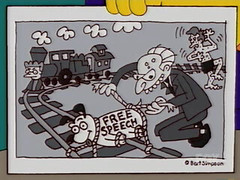Wikipedia and Open Journalism
Any discussion of Open Journalism is incomplete without a mention to Wikipedia. It has evolved as a potential source of information. It has even developed its own passionate fanbase called 'wiki-fiddlers'. Let us analyse the viability of wikipedia as a plausible solution to Open Journalism.
In a recent article on The Register, wikipedia cofounder Jimmy Wales, acknowledged that there are serious quality problems with the online work. This has initiated a lively debate as to the usefulness of wikipedia. Due to its collaborative framework, there has always been a problem of factually incorrect information which hampers its credibility. Moreover, sometimes even when the article is factually correct(in parts), it lacks a logical and consistent flow, which dilutes the intent of the article. In some cases, the article is crammed with too much redundant information, which again dilutes the original intent. Also, another co-founder admits of anti-elitism or lack of respect for expertise. Flamewars on controversial topics is also very common.
A lot of fixes are being suggested. The predominant being, maintaining 2 versions of the article - a stable and a updated. The stable version, is a verified (possibly old) version of the article ( ensures correctness of information ). Whereas the updated version, is the latest version ( having unverified content ). Now, the user has the option to search either the verified content or the latest content. The original author can be involved in the verification process which will help to ensure coherence. There is also a suggestion to include some rating mechanism, which will help to remove redundant content, weed out vandals and reward expertise. About controversial topics, keep the main story fairly unbaised and introduce separate comments to debate the issue.
We have learnt a lot from the wikipedia experience. The most important being collaborative intelligence and distributed editing, both of which would be critical to implement true Open Journalism. The problem with wikipedia is its implementation, not the concept.
In a recent article on The Register, wikipedia cofounder Jimmy Wales, acknowledged that there are serious quality problems with the online work. This has initiated a lively debate as to the usefulness of wikipedia. Due to its collaborative framework, there has always been a problem of factually incorrect information which hampers its credibility. Moreover, sometimes even when the article is factually correct(in parts), it lacks a logical and consistent flow, which dilutes the intent of the article. In some cases, the article is crammed with too much redundant information, which again dilutes the original intent. Also, another co-founder admits of anti-elitism or lack of respect for expertise. Flamewars on controversial topics is also very common.
A lot of fixes are being suggested. The predominant being, maintaining 2 versions of the article - a stable and a updated. The stable version, is a verified (possibly old) version of the article ( ensures correctness of information ). Whereas the updated version, is the latest version ( having unverified content ). Now, the user has the option to search either the verified content or the latest content. The original author can be involved in the verification process which will help to ensure coherence. There is also a suggestion to include some rating mechanism, which will help to remove redundant content, weed out vandals and reward expertise. About controversial topics, keep the main story fairly unbaised and introduce separate comments to debate the issue.
We have learnt a lot from the wikipedia experience. The most important being collaborative intelligence and distributed editing, both of which would be critical to implement true Open Journalism. The problem with wikipedia is its implementation, not the concept.
